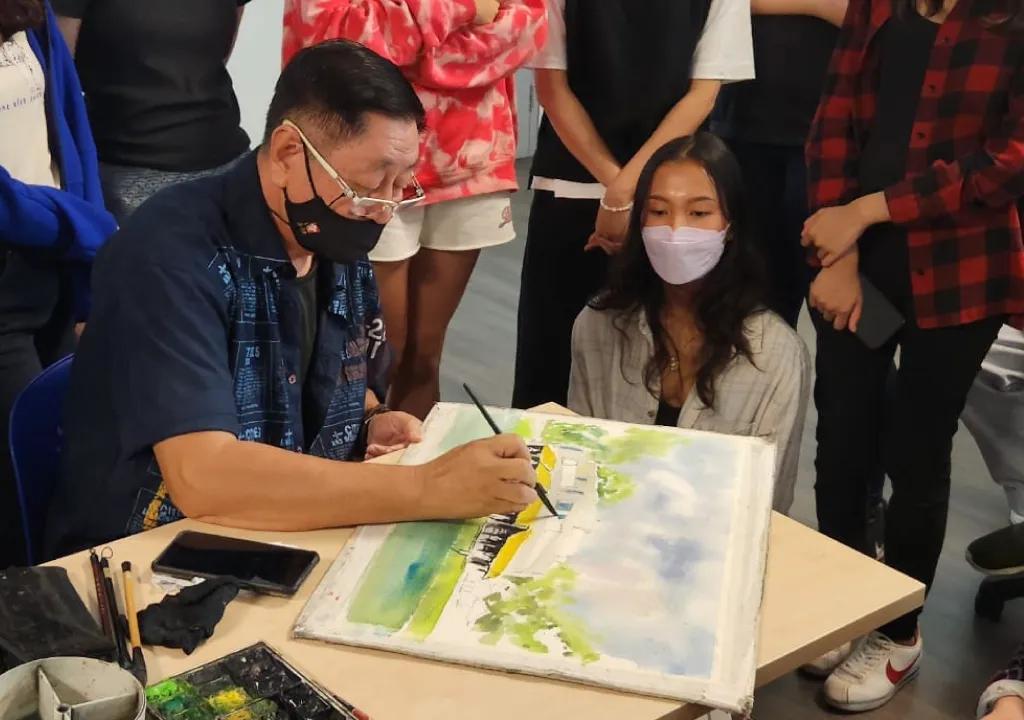Follow in the Footsteps: A Sharing Session and Live Painting Demonstration by Artist Chen Peng Sen
Bandura's social cognitive learning theory suggests that individuals learn from one another. The theory states that individuals learn via observation, imitation, and modelling (Bandura 1999). In Art and Design, a demonstration is often used as a teaching tool to model possibilities for technical problems and solutions to support student learning.
Demonstrations assist in teaching a skill through multiple steps. Students can be inspired by seeing authentic art being made along with the tools being used. It engages the audience and encourages participation through live observation, and enhances recollection of steps and techniques for tasks later. Artists and art educators can share their specialised knowledge of tools, art techniques and concepts by way of demonstration to an audience.
Recently, an opportunity to arrange a demonstration and sharing session for Drawing Techniques and Process by Artist Cheng Peng Sia who is an experienced artist with a background in architecture and education who has exhibited his works nationwide and around the world. The demonstration was specially arranged and designed to scaffold students’ learning as they prepare for their Exterior Space assignment using watercolour. The demonstration conveyed knowledge for students to use immediately, which is not only beneficial but also very inspiring, learning from his experience as an active committee member with Sketchwalk Kuala Lumpur.
Since drawing is a core subject for both the (BA (Hons) Design Communication) and the BA (Hons) in Interior Architecture programmes, the size of the class is also considered as it can impact the effectiveness of the demonstration (Smith, Wenderoth, & Tyler 2013). The use of a webcam to project the demonstration activity onto a large screen in a class with a large number of students proved to increase the visibility for all participating students. It also allows online students who were unable to attend the physical class to also benefit from the live recording, as well as enabling later re-watch and review functions.
Mr Chen started sharing his background and some of his experience in outdoor sketching. He also brought along 50 copies of the exhibition catalogue for Sketchwalk Kuala Lumpur to share with the students. Before he began his demonstration, he tried to understand the student’s drawing background and needs, even though the students were not ready for live sketching at this stage. He selected the hip Foodhub @ Sky (Mixed food stores) adjacent to the university campus as the sketching topic for this afternoon, which was a place familiar to the students.
First, he started with compositional possibilities concerning perspective, viewpoint, and angle. He also provided effective solutions to capture a sense of depth and form, how to deal with two-dimensional perspective, and anchoring the subject to the background. Upon the request of the students, he placed the subject building in front of a lake using reflection techniques. While he is doing a one-hour-plus demonstration, with an informative step-by-step explanation, he also discussed the materials, colours, and techniques he used and the desired effects, and gave helpful advice to some of the questions raised by the student.
Overall, it was a truly enjoyable experience for both students and Mr Chen, and despite a five-decade age difference, there was no barrier or generation gap when discussing art. The student appreciated his flexibility and adaptability, as he is open to suggestions and ideas and willing to answer any question, even during his demonstration. The students were inspired and gained more confidence through the step-by-step demonstration. They were able to independently complete the task immediately with a more complete understanding of the medium, techniques, and process.
Helen Guek Yee Mei
School of Arts
Email: @email




